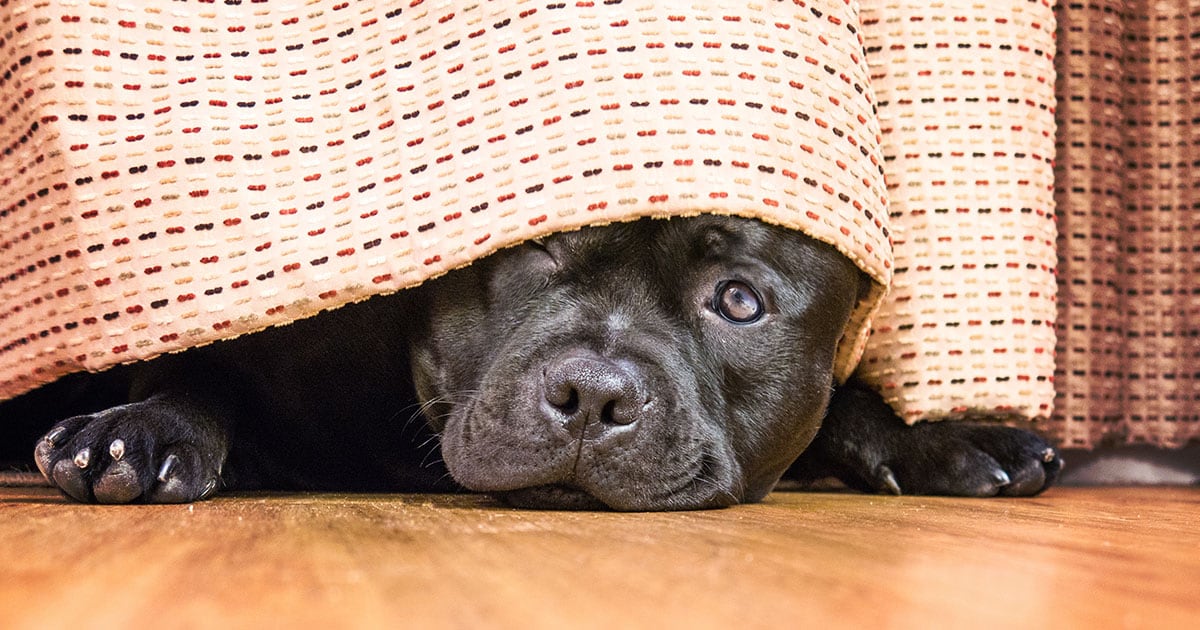“Rescue Me” is a recurring column by Samantha Randall, editor-in-chief at Top Dog Tips. She’ll provide personal anecdotes and perspective about her life as a pet lover with a passion for cat and dog rescue. Today, she offers tips on how to successfully adopt a timid dog.
When you adopt a dog, you might not know what kind of personality they have. Some shelters and rescue groups may provide this information, but you may have to go on limited info and interaction.
However, if you know that the dog you wish to adopt is shy and timid, then you can take certain steps to ensure that he or she will feel comfortable right from the start. I’ve been in situations like this in the past, so here are some of my personal tips.
Prepare Your Home
The first thing to do is to manage the environment so your new pet can feel at home. Keep in mind that it will still take some time for the new dog to get used to this new situation, but if you prepare your home ahead of time, it will be easier for both of you.
Start with the backyard, if you have one. Make sure that the fence is high enough to prevent the dog from climbing or jumping over, and that the backyard is fully fenced. Check the fence for holes as well.
Inside the house, make sure that all your doors close and lock properly and that your windows are all closed as well.
Provide the Dog with Personal Space
Once you secure your home, it is time to create a cozy environment for your pooch to use as personal space. Designate a small and quiet room just for your dog. Buy a crate that is the appropriate size, meaning that it is tall enough for your new dog to comfortably stand and long enough to lie down.
Most timid dogs will appreciate the crate and feel comfortable and protected in it. Keeping your new pet in the crate at the beginning will protect them from ingesting potentially dangerous items and from escaping your home when you are out. It will also protect your household items from destructive chewing.
After you find the right crate, it’s time to put some stuff in it. The crate should contain some type of bedding. If your new dog likes to chew, you should consider something durable or chew-proof. You should also put some toys in the crate so your dog doesn’t get too bored, although it’s important to make sure that the toys are safe for your dog’s size. Don’t leave food and water in the crate, unless you plan to be out for a while.
Some dogs may fear crates. If that’s the case, keep them in a small, secured area. You can use baby gates to enclose the dog and keep them safe. Just be sure they can’t leap over it!
Get the Right Equipment
To ensure your dog’s safety when you go on walks, you also need equipment. First, you will need a leash that’s five to six feet long. You will also need a collar and a body harness. It’s best to go with a no-pull harness since most adopted dogs are not properly leash trained and tend to pull on the leash.
Your new friend may be scared of walking on a leash or might be easily startled by traffic and other loud noises. That’s why you should always walk your dog with the leash attached to both the harness and the collar for added security. After your dog gets used to walking on a leash, you can usually stick to just a harness or a collar.
In addition to walking equipment, you will need other supplies like high-quality dog food and treats, toys, etc. When you buy toys for your pooch, go with the non-squeaky ones since noisy toys might scare them.
Working with Your Timid Dog
The most important thing to keep in mind is that it will take time and patience for a timid dog to socialize with other pets and people. If your new dog is very shy, let them be alone in their room/crate for a few hours every day.
Your dog will watch you and try to make sense of the new environment. Give them time to get comfortable and use an upbeat tone of voice, along with unthreatening body language. Make sure that you don’t sound too anxious or your dog may think something is wrong and become concerned. It is best to get down to your dog’s eye level when you talk, instead of standing over them or bending at the waist.
Establish Routine
The next step is to establish a regular daily routine. That includes feeding, sleeping and walking. Try to do these things at the same time every day so your dog can get into the routine and get comfortable with it.
Gain Their Trust
Don’t try to force your new dog to accept petting or handling. At first, you can simply spend some quiet time with your pooch, sitting on a floor nearby. Offer an occasional treat but don’t try to approach them with it — just gently throw it instead. Let your dog come to you, and after a while, it’ll happen naturally.
Once your dog becomes more trusting and starts coming to you for treats, you can try to gently pet them. Reward the progress, no matter how small the step is, with a treat and praise. And once your dog allows petting, stroke the chest instead of the head since the hand coming from above can be seen as threatening and may cause your dog to react.
Get Some Help
Your dog’s behavior should change over a few days and weeks. They should become more open and accepting of your petting and handling as they get used to this new living environment and daily routines. But if you don’t notice any progress within a few weeks, or you can’t move past a certain plateau, contact your veterinarian for advice. The vet may even refer you to a veterinary behaviorist who could help your pooch live a fear-free life.
And even as your dog comes out of their shell, you still need to be careful and avoid making loud noises, like vacuuming or listening to loud music. Also, when you introduce your pooch to new people or animals, do it slowly and carefully. It’s best to prepare some treats for your visitor to offer during the introduction.
In the end, your dog can also benefit and gain more confidence from basic obedience training or going to socialization classes. But they need a baseline of comfort before you can try these tactics.
Adopting a timid dog requires a lot of patience and time for the dog to become free of fear and to learn how to trust you. But if you let your new pet get comfortable around you at their own pace and you make the necessary preparations to help them feel at home, you’ll likely find a new friend for life.







